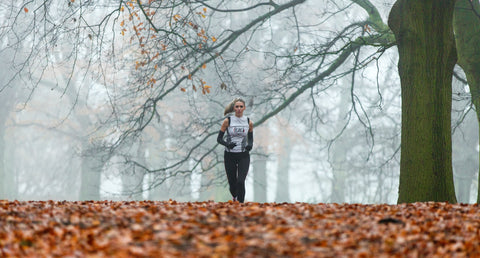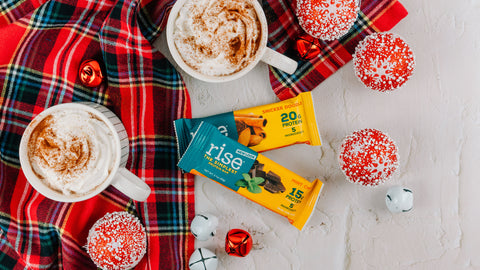Do you have to ditch your outdoor workouts when cooler weather rolls into town? We say not if you don't want to!
While there's nothing wrong with indoor exercise, outdoor workouts come with added benefits you shouldn't give up.
You can absorb vitamin D from the sun and let nature lower your stress and anxiety. You may also feel less cooped-up during this time of year, which is hard enough without COVID-19 making it worse.
Here's the best part: you may actually burn more calories outside when it's cold as your body works harder to keep you warm.
So now that you’re in (to work out outside), let’s talk game plan.

3 Tips for How to Stay Warm with Your Outdoor Workout
Use these three tips for how to stay warm while working out, and chilly weather workouts may become your new favorite:
1. Plan Your Outdoor Workouts Around the Forecast
Scheduling your workouts is one of the best ways to maintain your fitness and clean eating goals during the holidays.
When it’s cold outside, you’ll need to factor in the weather forecast on top of all your other to-dos and obligations.
So pick one day each week to plan your daily workouts and make sure to:
- Check the high/low temperatures. Try to pick the warmest days of the week and the warmest times of the day to sweat outside.
- Watch the wind chill, which can make the temperature outside feel much colder than it actually is.
- Pay attention to precipitation. Unlike a sun shower in the summer, sleet and snow may not feel good mid-workout. It can also be dangerous and make you prone to slips and falls.
Once you know what the week has in store, you can schedule your outdoor workouts for the best days and your hot indoor yoga or spin class for when the forecast calls for snow.
This intel will also give you an idea of how to dress for your outdoor workout, as our next tip highlights.

2. Dress in Moisture-Wicking Layers
You may be wondering what to wear when working out outside, especially when it’s cold out. The secret is to ditch the cotton and flannel and opt for layers of moisture-wicking synthetic fabrics.
While your cotton pajamas keep you cozy and warm inside, this fabric doesn’t work well when you’re exercising outdoors.
As you start to sweat, or if your clothes get damp from precipitation, the cotton will stay wet and take forever to dry (double so in frigid temperatures). This turns into a frosty outfit that only makes you colder and more uncomfortable.
On the other hand, moisture-wicking synthetic fabrics like polyester and fleece resist wetness. For a natural option, merino wool will also keep you dry and warm.
You’ll want to stick to the three-layer dressing system, which includes a:
- Base layer. This tight first layer should keep your body heat in. Thin merino wool pieces work great for this.
- Middle layer. This can be a bit looser than your base layer, but not by much. Choose polyester, fleece, or wool here.
- Outside layer, which should protect you from both windy and wet conditions. Look for jackets with durable water-repellent coatings in fabrics like nylon and polyester. Zippers, elastic cuffs, a hood, and a drawcord hem will also seal out the elements and keep you dry and warm.
Make sure your outside layer is large enough to accommodate both your middle and base layers comfortably. Your workout outfit should feel snug to keep your core warm but not restrictive.
Lightweight outside layers are best since you can take them off and easily wrap them around your waist if your body starts to heat up.

3. Keep Your Extremities Warm and Engaged
Dressing in layers will help your core stay warm, making it easier for your body to pump heat to your extremities. Bad news: your head, hands, feet, and ears tend to lose heat much quicker than your core.
So give your body a helping hand by protecting your extremities and trapping in warmth. Think about wearing a hat, scarf, gloves, earmuffs, or balaclava. And don’t forget warm socks and the proper shoes for your exercise/weather conditions.
Always choose moisture-wicking, water-repellent fabrics to block dampness and wind.
Don’t forget to keep your extremities moving. Wiggle your fingers while you run or do small leg circles during your water breaks. Your blood will continue pumping to these areas and make your body warmer as a result.

Now You Know How to Stay Warm with Your Outdoor Workouts
It’s easy to follow these three tips for how to stay warm while working out during the coldest months of the year.
When you schedule your exercise according to the forecast and know what to wear when working out outside, you may discover that fall and winter outdoor workouts are even better than those in the spring and summer.
After all, if you’re not dripping in sweat within the first five minutes, you may be able to exercise longer. And without the blazing summer sun in your face, you may find it easier to boost your workout intensity.
So get outside, and take advantage of the cooler weather today! It won’t last forever.
Author: Devan Ciccarelli
Email: devan@behappynothangry.com
Instagram/Facebook Group: @behappynothangry/Be Happy Not Hangry
Website: www.behappynothangry.com




